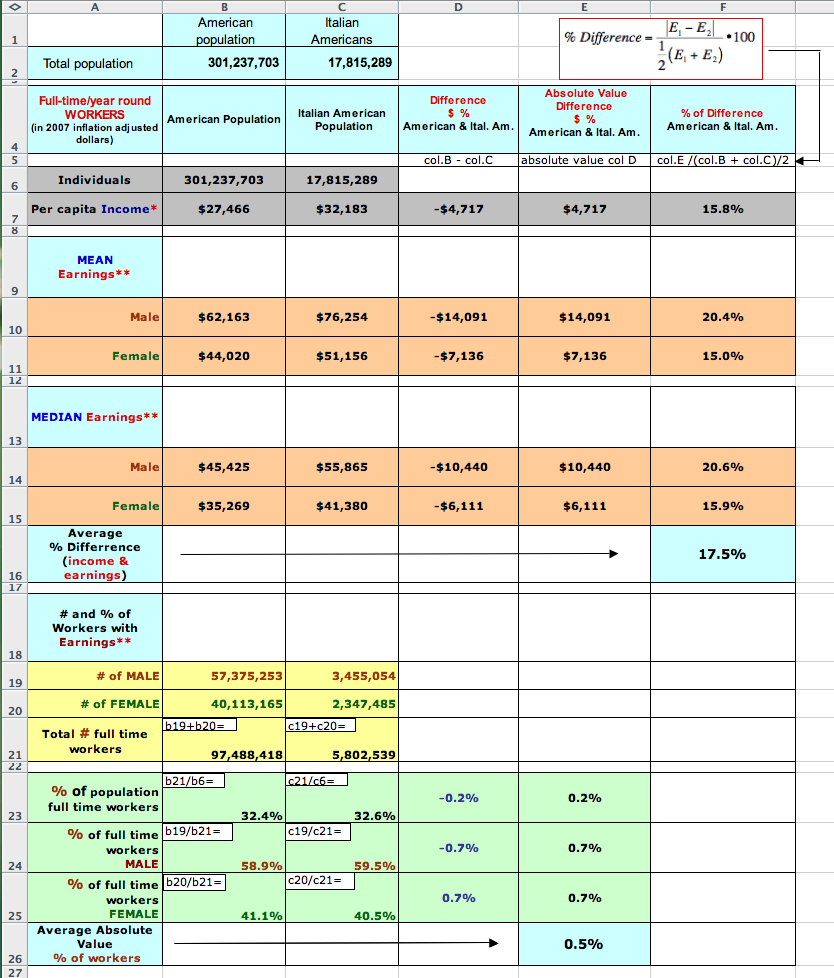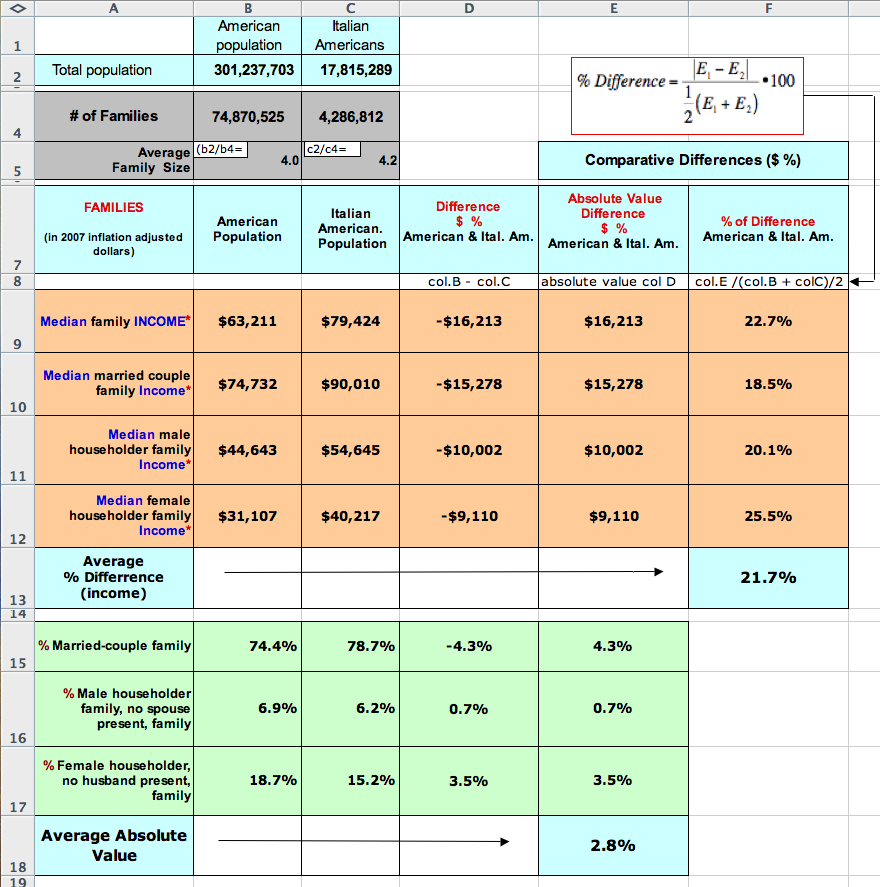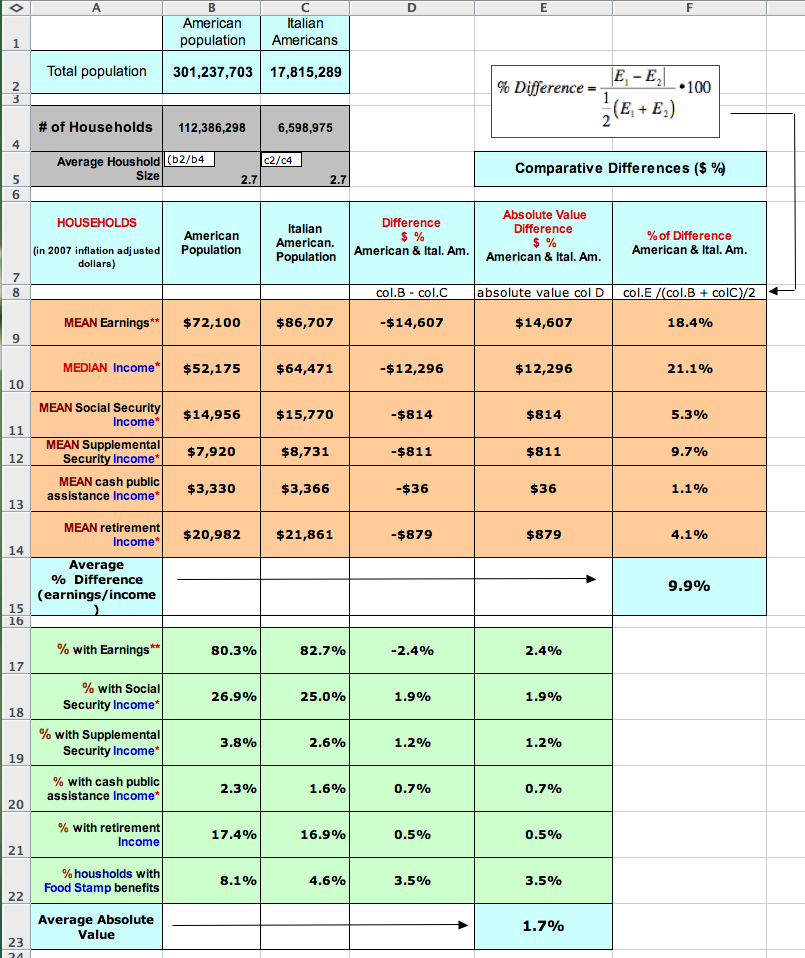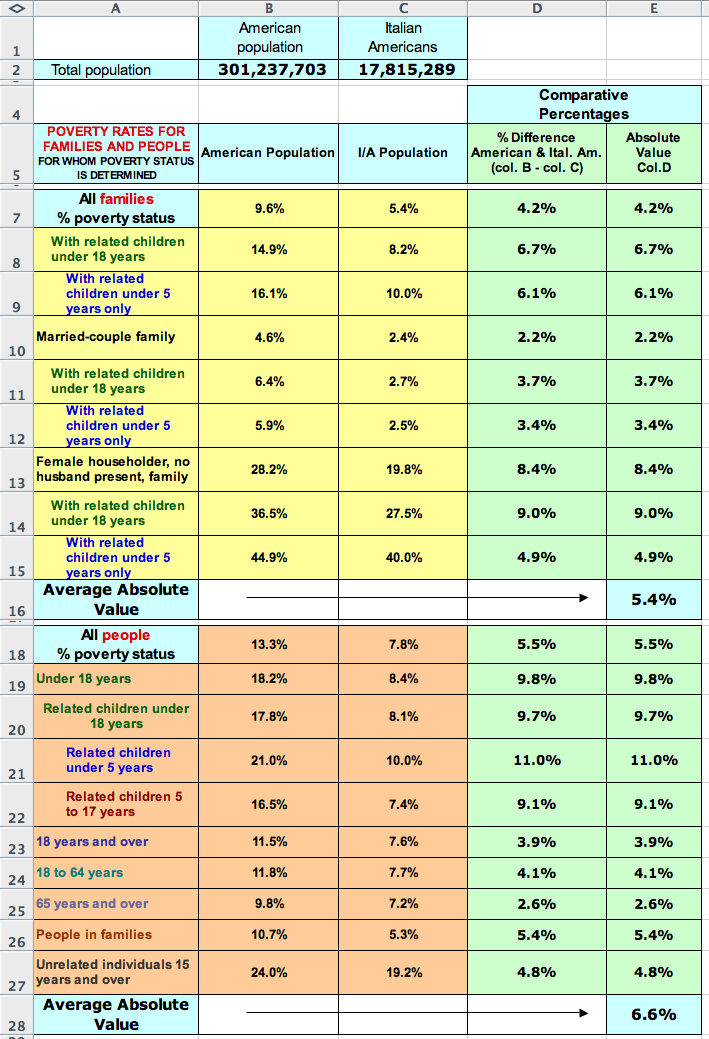Italian Americans by the Numbers – Income, Earnings & Poverty
Italian Americans by the Numbers – Income, Earnings & Poverty
(November 23, 2009)
The work ethic of Italian Americans has been largely rewarded in terms of income and earnings.
In the previous six reports of this series, there was no significant measurable difference to be found between the Italian American population and the American population as a whole.
However, in this report we see some very significant differences in income and earnings measures. Also, poverty is a reality in our community!
In the previous six reports of this series, there was no significant measurable difference to be found between the Italian American population and the American population as a whole. However, in this report we see some very significant differences in income and earnings measures. Also, poverty is a reality in our community!
Series Preface
This blog series, “Italian Americans by the Numbers”, presents demographic data about Italian Americans based on the US Census Departments “2005-2007 American Community Survey (ACS)”. “The ACS collects and produces population and housing information every year instead of every ten years. The 2005-2007 ACS three-year estimates are based on data collected between January 2005 and December 2007.”
For a more detailed introduction to the ACS, please see the first article in this series “Italian Americans by the Numbers - Comparative ethnic population totals and percentages” located at
i-Italy.org – Bloggers– “South of Rome West of Ellis Island”
or click on the link in this article.
If there are any questions, comments or requests, please place them in the comments section below and/or write to me directly at [email protected]. (If you place a note in the comments section, please send a copy to my e-mail address. The auto response system of the comment section may not notify me.)
Summary of Series Reports to date:
1. “Comparative ethnic population totals and percentages”
2. “Where we live”
3. “Age, Gender & Generations”
4 “Households, Marital Status, “Mammoni”;
“What does it mean to be Italian American?”
5. “Education: Who will educate our children”
6. “Employment”
To view these reports, click on links in this report or go to my blog in the bloggers section here at i-Italy.
////////////
DEFINITONS
terms used in this report
Census Department Definitions:
INCOME *
“The sum of the amounts reported separately for wages, salary, commissions, bonuses, or tips; self-employment income from own nonfarm or farm businesses, including proprietorships and partnerships; interest, dividends, net rental income, royalty income, or income from estates and trusts; Social Security or Railroad Retirement income; Supplemental Security Income (SSI); any public assistance or welfare payments from the state or local welfare office; retirement, survivor, or disability pensions; and any other sources of income received regularly such as Veterans' (VA) payments, unemployment compensation, child support, or alimony.”
EARNINGS **
“The algebraic sum of wage or salary income and net income from self-employment. Earnings represent the amount of income received regularly before deductions for personal income taxes, Social Security, bond purchases, union dues, Medicare deductions, etc.”
Household
A household includes all the people who occupy a housing unit as their usual place of residence.
Household size
The total number of people living in a housing unit.
Household type and relationship
Households are classified by type according to the sex of the householder and the presence of relatives. Examples include: married-couple family; male householder, no wife present; female householder, no husband present; spouse (husband/wife); child; and other relatives.
Householder
The person, or one of the people, in whose name the home is owned, being bought, or rented.
If there is no such person present, any household member 15 years old and over can serve as the householder for the purposes of the census.
Two types of householders are distinguished: a family householder and a nonfamily householder. A family householder is a householder living with one or more people related to him or her by birth, marriage, or adoption. The householder and all people in the household related to him are family members. A nonfamily householder is a householder living alone or with nonrelatives only.
Statistical Definitions
Mean
The sum of a list of itemized numbers divided by the number of items in the list.
For example, given the following list of 5 itemized numbers:
9, 3, 44, 17, 15
The sum: 9+3+44+17+15= 88
The MEAN: 88/5=17.6
Median
The middle value in a list of numbers arranged from smallest to largest
For example, given the same list of numbers as above
9, 3, 44, 17, 15
Arrange the numbers from smallest to largest
3, 9, 15, 17, 44
The middle number 15 is the MEDIAN
Absolute Value
The absolute value of a number is the number without plus or minus signs. Thus, for example, the absolute value of a +3 is 3 and the absolute value of a -3 is also 3. [Note: further discussion of absolute value in the discussion section at the end of this report]
Percent Difference between two numbers
The formula for computing the percent of difference between two numbers is as follows:

In words: the absolute value of the difference between two numbers
(|E1 - E2 |) divided by the average of the two numbers [(.5 * (E1 + E2)] times 100.
[Emphasis: my understanding of ‘absolute value and ‘percent difference’ and their application is based on decades old recall of freshman college algebra, Needless to say: anyone who thinks my math erroneous or my logic fallacious, or has any other questions or comments, PLEASE advise via my above e-mail address! Thank you.]
////////////////
Raw Data vs. Presentation and Analyzed Data
Raw data refers to the numbers reported by the Census Department. For example, the Census Dept. reports that the population of the US is 301,237,703 and the Italian American population is 17,815,289.
Raw data from the Census Department’s online database can be ‘downloaded’ to a personal computer in various formats such as an Excel Spreadsheet.
An example of this Excel ‘downloaded’ raw data is a follows:

Description and Analysis

/////////////////////////////////


Researchers trained in quantitative concepts and methods of analysis, and spreadsheet techniques need no more than the downloaded data to do their work.
However, the vast majority of scholars educated in the humanity’s disciplines and a large number educated in the social sciences lack training in quantitative concepts, methods and techniques. Indeed, many students go into humanities and social sciences precisely because they “hate math.”
Accordingly, the quantitative researcher, who wants to make his/her work public and most importantly teach students the results of quantitative research, must transform raw data and its analysis into a presentation format that is meaningful to those who are not trained in quantitative methods.
This “Italian Americans by the Numbers” series has attempted just that: i.e. make Census Dept. raw demographic data about the Italian American people meaningful to those who might otherwise never see the data or be comfortable with the raw data.
Accordingly, what the reader “sees” in these reports is much different than the raw data. Color-coding, for example, and other formatting techniques play a significant role in trying to make data not only meaningful but also interesting. Also, raw data is ‘reorganized’ in presentation format. What appears on line 25 in the raw data spreadsheet may be seen on line 40 in a presentation format.
This transformation of data is what historians call the transmission of documents. Often the document that a historian has to work with is a copy of an original document. The historian has to be alert to errors made in the coping process.
With that in mind, at end of this report I have placed the original downloaded Excel spreadsheets with the raw income, earnings and poverty data. They can be used to check my work for errors or further analysis.
Description and Analysis
Also, raw data in itself is not very enlightening. Raw data are measurements. It is only when the measurements are analyzed do they become enlightening.
For example, the raw data reports that the average household income of the total population of Americans is $52,175, and that of Italian Americans $64,471. Those are the measures (i.e. raw data).
Analysis begins, for example, by subtracting the Italian American population's 'household income' from the total American population's and finding that Italian American household’s income is $14,607 greater. More analysis is provided by computing the percentage of difference between the two populations and finding that the Italian American household income is 21.1% greater that the American population as a whole.
Percentages, in turn, are used to compare the difference in household income with other measures such as employment. Percentages can also be used to compare present measures with the past; thereby, ‘seeing’ changes that take place in the Italian American population over time. Percentages can also be used to compare Italian Americans with other nationality and ethnic groups.
/////////////
Accordingly, there are three types of information contained in these reports:
1. Descriptive Measures (quantities and percentages) of the American population in general.
2. Descriptive Measures (quantities and percentages) of Americans who identified themselves as of Italian descent.
3. Comparative Measures (percentages) of Americans generally and Americans of Italian descent.
“Comparative percentages” provide us with a measure of similarities and differences between the American population in general and Italian American population, thereby helping us understand who we are.
Further, in an attempt to quantify and make more objective the relative similarities and differences between the two populations I used the “Average Absolute Value” and “Percent Difference” techniques mention above.
As noted above, the absolute value of a number is the number without plus or minus signs. Thus, for example, the absolute value of a +3 is 3 and the absolute value of a -3 is also 3. Removing the plus and minus signs makes it possible to compute average differences for many measures.
------------
Introduction
American Community Survey Income & Earnings statistics are presented here in four tables:
I. Individual Earnings
II. Household Earnings & Income
III. Family Income
IV. Poverty Status
There are two types of quantitative values in the tables:
(1) Numbers which have been ‘given’ in the Census and
(2) Numbers which have been ‘computed’. Once ‘given’ measures by the Census, ‘analysis’ is done by ‘computation’.
In an effort to facilitate understanding of the computations, I have place, what I call, ‘computation boxes’ showing how the computed numbers was arrived at. Or, if the computation is the same for the whole column, I place the formula in the column heading.
For example, in an illustrated table segment below:
The number in ‘cell’ column B row 4 (112,386,298) is ‘given’by the Census Dept. It represents the total number of American Households. Similarly, the number in cell C4 (6,598,975) is ‘given’ and represents the number of “Italian American Households”.
Moving to cell B5, the number in that cell 2.7 is ‘computed’, as indicated in the ‘computation box’ in the upper left-hand corner, by dividing the number in cell b2 by the number in cell b4 (i.e. 301,237,703 / 112,386,298). This number 2.7 represents the “Average Household” size.
Notice the column heading in cell D7. The text ‘(col. B – col. C)’ means that all the numbers in that column have been computed by subtracting the number in column C from the number in column B.
Illustration Table

/////////////////////////////////
Table I.
Individual Income & Earnings

Discussion Table I
1. As noted in the “Definitions” section of the introduction, “Income” and “Earnings” are two different categories of cash flow.
There are two things that are noteworthy in this table.
a) The amounts in column D are all negative. Because the formula for computing those amounts is subtract column C from column B (col. B - col. C) the negative numbers mean that the income and earnings of Italian Americans is greater than the American population as a whole.
b) The percentages in column F are relatively large which means that the income and earnings of Italian Americans is not only larger than the American population it is significantly larger.
The ‘Average % of Difference’ between the two populations is 17.5 (col. F row 16)
Also, note in the lower section of the table “# and % of Workers with Earnings”, there is very little difference between Italian Americans and the American population as a whole.
In short, Italians Americans on average make more money than average Americans. This is especially significant because cell F26 (0.5%) shows that the percentage of the Italian American population in the workforce is about the same as the American population as a whole.
Table II.
Family Income


Discussion Table II Family Income
Table II is pretty much the same story as Table I.
Again note: the negative dollar amounts in column D rows 9-12 mean Italian American Family income is larger than population as whole, and the percentages in Column F on average 21.7 % (F13) difference between the two populations is also large.
Rows 14-16 indicate that on a percentage basis there is not much difference between the two populations in terms of household family make-up.
Table III.
Household Income & Earnings

Discussion Table III Household Income & Earnings

Discussion Table III Household Income & Earnings
Again, at the Household level of measured income and earnings, Italian Americans still show making more money than the American population as a whole.
Interestingly though, the spread is not so great. The Average % Difference (F15) is 9.9% which is significantly less than the difference of individuals 17.5% and more than half as much as the difference of 21.7% at the family level.
I’m not sure how to interpret, what seems to me an anomaly. Why would the family differential be so much less than the household? At a later date I will probe this further. But, if anyone has any thoughts, please do pass them on to me. Thank you.
Table IV.
Poverty



Discussion Table IV Poverty
Happily for Italian Americans, all the numbers in column D are positive. Which means that in all categories of poverty measures, Italian Americans are less impoverished that the American population as a whole. This seems consistent with Table I-III indicating that we make more money than the population as whole.
Unhappily, in some categories the percentages are very high and much further consideration needs to be attended to them. For example, in the population of “Female householders with related child under 18” (row 14) 27.5% are in poverty. Worst yet, “Female householders with related child under 5” (row 15) fully 40% (almost half) are in poverty.
Summary discussion
1. What does it mean to be an Italian American?
In the previous six reports of this series there was no significant measurable differences to be found between the Italian American population and the American population as a whole. There was nothing in the quantitative measures of the Census Dept. studies that differentiated Italian Americans from the total population of Americans.
However, in this report we see some very significant differences in income and earnings and measures.
What is to my mind interesting about these large differences in earnings and income is that it they do not seem to correlate with the education numbers in report #5. The numbers in that report seem to indicate that there was no significant difference in the education levels of the Italian American population and the American population as a whole.
Accordingly, we cannot conclude that Italian Americans make more money because they are better educated. How than does one explain the sizable difference in earnings?
2. Poverty
The poverty numbers are of special interest to me. I feel that for all the talk of Italian American Community and Culture, Italian Americans are not demonstrating their sense of community by helping their own people.
In the greater Rochester, NY Metro Area there is approximately 200,000 Italian Americans (20% of population). There is a very high degree of Italian consciousness and pride as indicated by the many clubs, organizations, etc. All well funded and attended by upper middles class and ‘fat-cats.’
In my years working in construction and kitchens, I have known many Italians and Italian Americans who are so hard pressed that any moral person would fell pain for them. Hard working family people with children. And, yet there is not one of these very well funded organizations, clubs, groups (indeed, individuals) that these so called ‘paesano(e)’ can turn to for help.
Of course if they give up their dignity and show up ‘hat in hand’, they will get a meal, a basket, a few dollars. But, there is no systemic proactive way that the well-off Italian Americans are reaching out to their ‘paesano(e)’, helping to lift them (i.e. Italian American children) up from poverty.
The next gala ball that we hear about, I wish we would reflect on the above poverty table. There is an old saying “Lies, Damn Lies and Statistics.” But, from my experience, the above poverty statistics are the ‘Damn Truth.” Tables I-III demonstrate we have the money to help our people (children) on Table IV.
3. Absolute Value (general discussion)
I’ve suggested that the absolute values of percent differences between two populations is a method of comparing the similarities and differences between the Italian American population the Total American population.
What follows is my understanding of my very old and dusty ‘college algebra’ textbook. I present it not to instruct; rather, to make clear my thinking.
Two values shown in the graph below are +3 and -3. Both represent distance from zero (0). The plus sign (+) indicates direction (i.e. to the right of zero). The minus sign (-) indicates direction (i.e. to the left of zero). The plus and minus signs indicate direction but not distance.

However, regardless of direction to the left or right, both distances are equal. Both are three units from zero. For example, think of two people standing on a street corner and the street corner is point zero (0). If one person travels 3 miles west (think to the right of zero) from a street corner and the other persons travel 3 miles east (think to the left of zero) from the corner, then both would have traveled the same distance, i.e. 3 miles, albeit in different directions.
To compute the average distance travel by both people, one has no choice but to use absolute values. To compute the average, add the two numbers and divide by 2. If one adds +3 and -3 the sum is zero. Zero divided by 2 equals zero. Obviously, the average distance traveled in this example is not zero.
Using absolute value: 3+3=6, 6/2=3. The average distance traveled by the two people is 3 miles. Which is obviously true.
Similarly, in the census tables above, when comparing the % of population numbers of the ‘total American population’ and the ‘Italian American population’, I subtract the Italian American population % from the Total American population %. Accordingly, if the ‘Italian American %’ is larger than the ‘Total American’ then the difference will be a negative %. Using the absolute values of the differences, gives a measure of the difference between the two populations in the measured category.
Again, anyone who thinks my math erroneous or my logic fallacious, PLEASE advise through e-mail [email protected]. The comments section’s notification process is inconsistent. E-mail assures that I will get your response. Thank you
4. Original data


4. Original data


DISCLAIMER: Posts published in i-Italy are intended to stimulate a debate in the Italian and Italian-American Community and sometimes deal with controversial issues. The Editors are not responsible for, nor necessarily in agreement with the views presented by individual contributors.
© ALL RIGHTS RESERVED - RIPRODUZIONE VIETATA.This work may not be reproduced, in whole or in part, without prior written permission.
Questo lavoro non può essere riprodotto, in tutto o in parte, senza permesso scritto.
Add a comment









